Transition to Professional Practice: Career Development Plan Report
VerifiedAdded on 2020/05/16
|8
|1837
|294
Report
AI Summary
This report details a student's professional career development plan, focusing on self-assessment, SWOT analysis, and strategies for success. The student acknowledges a lack of practical experience but aims to leverage the course to qualify as a professional. The plan includes setting objectives, staying accountable, maintaining a journal, and rewarding achievements. A SWOT analysis identifies strengths (passion, interpersonal skills), weaknesses (speech anxiety, poor critical thinking), opportunities (career development, critical care jobs), and threats (job security, self-confidence). The student outlines strategies to improve communication and critical thinking skills, including practicing, attending handovers, asking questions, and attending in-service sessions. A personal philosophy statement emphasizes patient-centered care. The report also outlines strategies to support career development and resilience, including self-care, knowledge updates, and improved management skills. The student concludes by emphasizing hard work, persistence, and seizing opportunities to achieve their career goals, highlighting the importance of self-care, knowledge updates, and management skills.
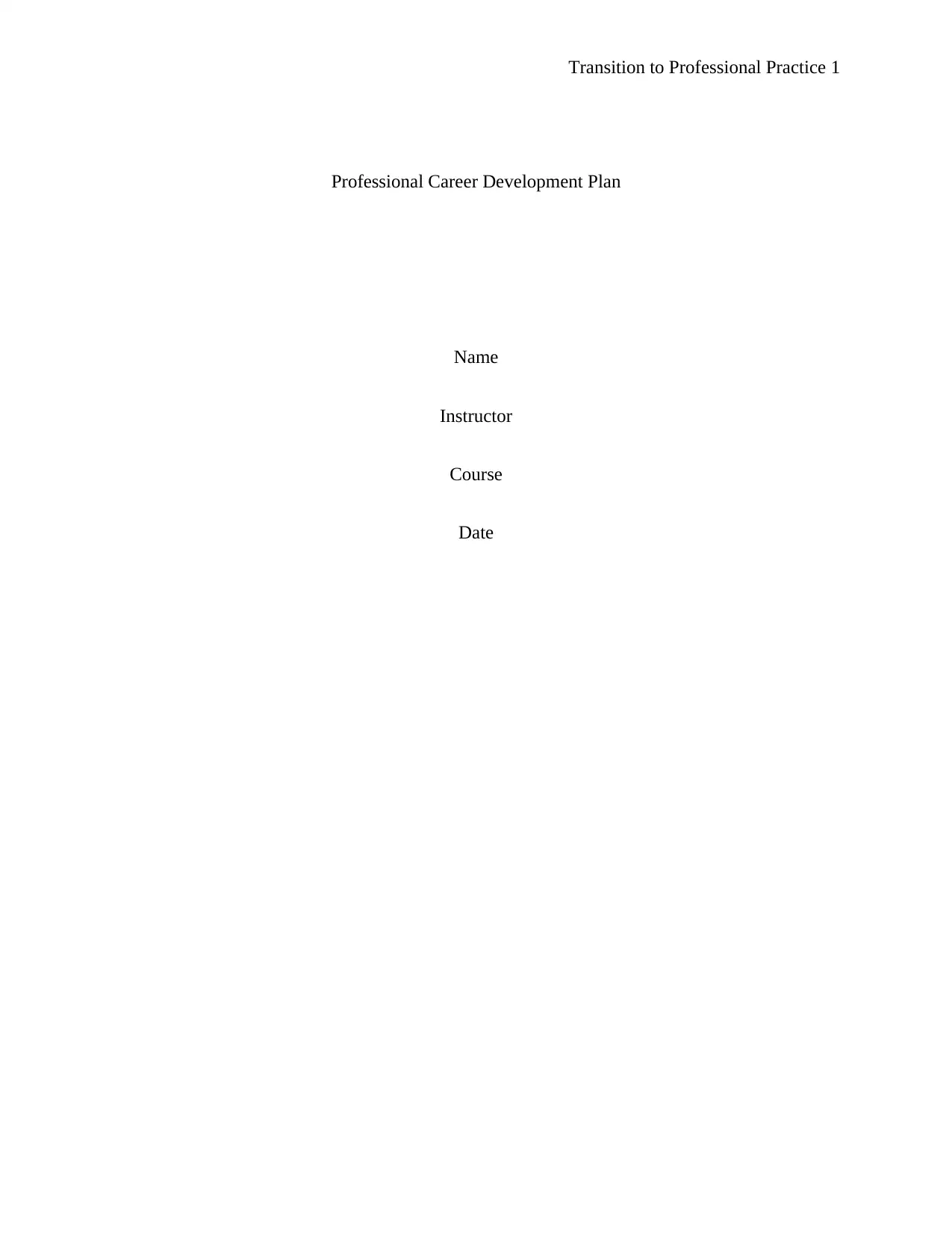
Transition to Professional Practice 1
Professional Career Development Plan
Name
Instructor
Course
Date
Professional Career Development Plan
Name
Instructor
Course
Date
Paraphrase This Document
Need a fresh take? Get an instant paraphrase of this document with our AI Paraphraser
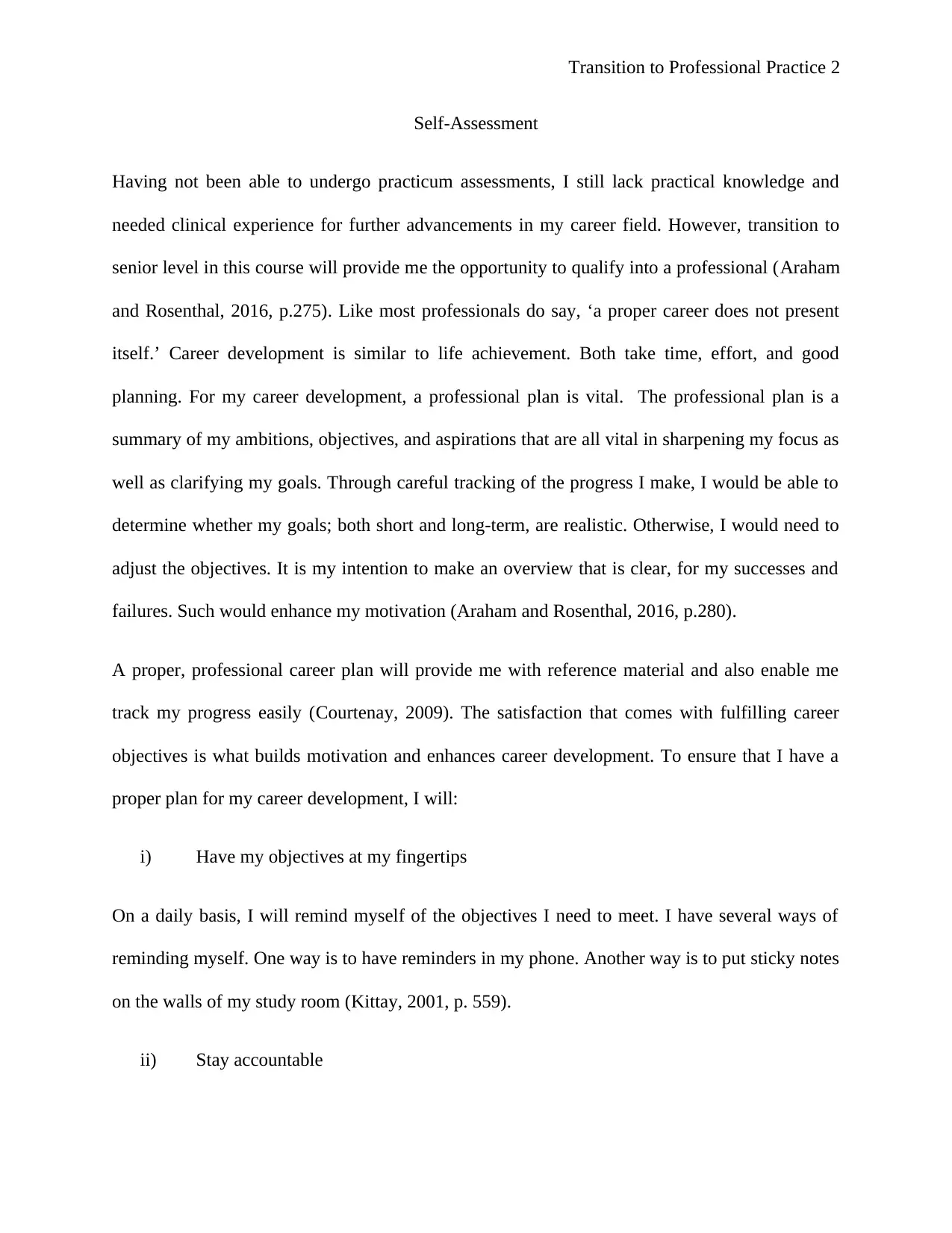
Transition to Professional Practice 2
Self-Assessment
Having not been able to undergo practicum assessments, I still lack practical knowledge and
needed clinical experience for further advancements in my career field. However, transition to
senior level in this course will provide me the opportunity to qualify into a professional (Araham
and Rosenthal, 2016, p.275). Like most professionals do say, ‘a proper career does not present
itself.’ Career development is similar to life achievement. Both take time, effort, and good
planning. For my career development, a professional plan is vital. The professional plan is a
summary of my ambitions, objectives, and aspirations that are all vital in sharpening my focus as
well as clarifying my goals. Through careful tracking of the progress I make, I would be able to
determine whether my goals; both short and long-term, are realistic. Otherwise, I would need to
adjust the objectives. It is my intention to make an overview that is clear, for my successes and
failures. Such would enhance my motivation (Araham and Rosenthal, 2016, p.280).
A proper, professional career plan will provide me with reference material and also enable me
track my progress easily (Courtenay, 2009). The satisfaction that comes with fulfilling career
objectives is what builds motivation and enhances career development. To ensure that I have a
proper plan for my career development, I will:
i) Have my objectives at my fingertips
On a daily basis, I will remind myself of the objectives I need to meet. I have several ways of
reminding myself. One way is to have reminders in my phone. Another way is to put sticky notes
on the walls of my study room (Kittay, 2001, p. 559).
ii) Stay accountable
Self-Assessment
Having not been able to undergo practicum assessments, I still lack practical knowledge and
needed clinical experience for further advancements in my career field. However, transition to
senior level in this course will provide me the opportunity to qualify into a professional (Araham
and Rosenthal, 2016, p.275). Like most professionals do say, ‘a proper career does not present
itself.’ Career development is similar to life achievement. Both take time, effort, and good
planning. For my career development, a professional plan is vital. The professional plan is a
summary of my ambitions, objectives, and aspirations that are all vital in sharpening my focus as
well as clarifying my goals. Through careful tracking of the progress I make, I would be able to
determine whether my goals; both short and long-term, are realistic. Otherwise, I would need to
adjust the objectives. It is my intention to make an overview that is clear, for my successes and
failures. Such would enhance my motivation (Araham and Rosenthal, 2016, p.280).
A proper, professional career plan will provide me with reference material and also enable me
track my progress easily (Courtenay, 2009). The satisfaction that comes with fulfilling career
objectives is what builds motivation and enhances career development. To ensure that I have a
proper plan for my career development, I will:
i) Have my objectives at my fingertips
On a daily basis, I will remind myself of the objectives I need to meet. I have several ways of
reminding myself. One way is to have reminders in my phone. Another way is to put sticky notes
on the walls of my study room (Kittay, 2001, p. 559).
ii) Stay accountable
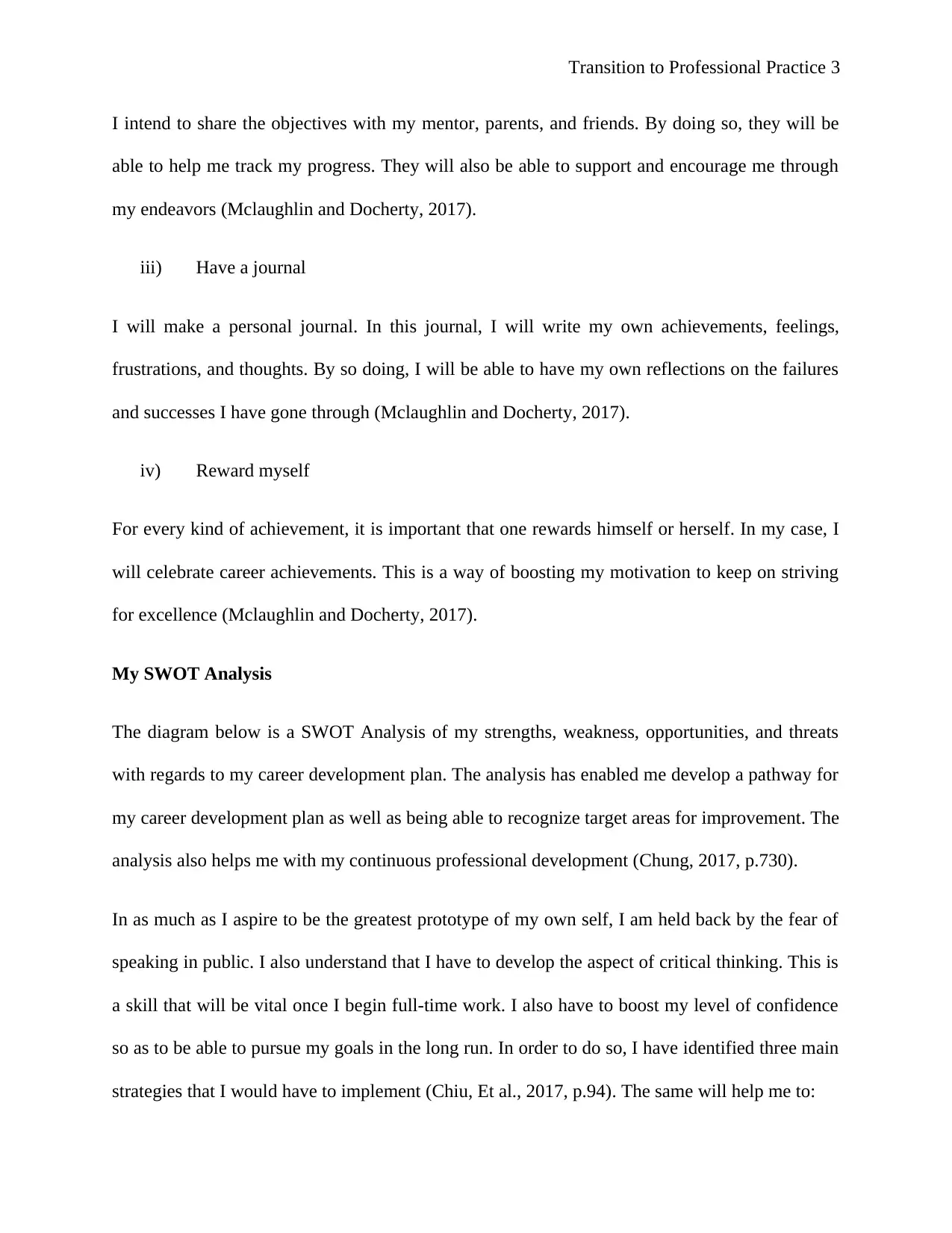
Transition to Professional Practice 3
I intend to share the objectives with my mentor, parents, and friends. By doing so, they will be
able to help me track my progress. They will also be able to support and encourage me through
my endeavors (Mclaughlin and Docherty, 2017).
iii) Have a journal
I will make a personal journal. In this journal, I will write my own achievements, feelings,
frustrations, and thoughts. By so doing, I will be able to have my own reflections on the failures
and successes I have gone through (Mclaughlin and Docherty, 2017).
iv) Reward myself
For every kind of achievement, it is important that one rewards himself or herself. In my case, I
will celebrate career achievements. This is a way of boosting my motivation to keep on striving
for excellence (Mclaughlin and Docherty, 2017).
My SWOT Analysis
The diagram below is a SWOT Analysis of my strengths, weakness, opportunities, and threats
with regards to my career development plan. The analysis has enabled me develop a pathway for
my career development plan as well as being able to recognize target areas for improvement. The
analysis also helps me with my continuous professional development (Chung, 2017, p.730).
In as much as I aspire to be the greatest prototype of my own self, I am held back by the fear of
speaking in public. I also understand that I have to develop the aspect of critical thinking. This is
a skill that will be vital once I begin full-time work. I also have to boost my level of confidence
so as to be able to pursue my goals in the long run. In order to do so, I have identified three main
strategies that I would have to implement (Chiu, Et al., 2017, p.94). The same will help me to:
I intend to share the objectives with my mentor, parents, and friends. By doing so, they will be
able to help me track my progress. They will also be able to support and encourage me through
my endeavors (Mclaughlin and Docherty, 2017).
iii) Have a journal
I will make a personal journal. In this journal, I will write my own achievements, feelings,
frustrations, and thoughts. By so doing, I will be able to have my own reflections on the failures
and successes I have gone through (Mclaughlin and Docherty, 2017).
iv) Reward myself
For every kind of achievement, it is important that one rewards himself or herself. In my case, I
will celebrate career achievements. This is a way of boosting my motivation to keep on striving
for excellence (Mclaughlin and Docherty, 2017).
My SWOT Analysis
The diagram below is a SWOT Analysis of my strengths, weakness, opportunities, and threats
with regards to my career development plan. The analysis has enabled me develop a pathway for
my career development plan as well as being able to recognize target areas for improvement. The
analysis also helps me with my continuous professional development (Chung, 2017, p.730).
In as much as I aspire to be the greatest prototype of my own self, I am held back by the fear of
speaking in public. I also understand that I have to develop the aspect of critical thinking. This is
a skill that will be vital once I begin full-time work. I also have to boost my level of confidence
so as to be able to pursue my goals in the long run. In order to do so, I have identified three main
strategies that I would have to implement (Chiu, Et al., 2017, p.94). The same will help me to:
⊘ This is a preview!⊘
Do you want full access?
Subscribe today to unlock all pages.

Trusted by 1+ million students worldwide
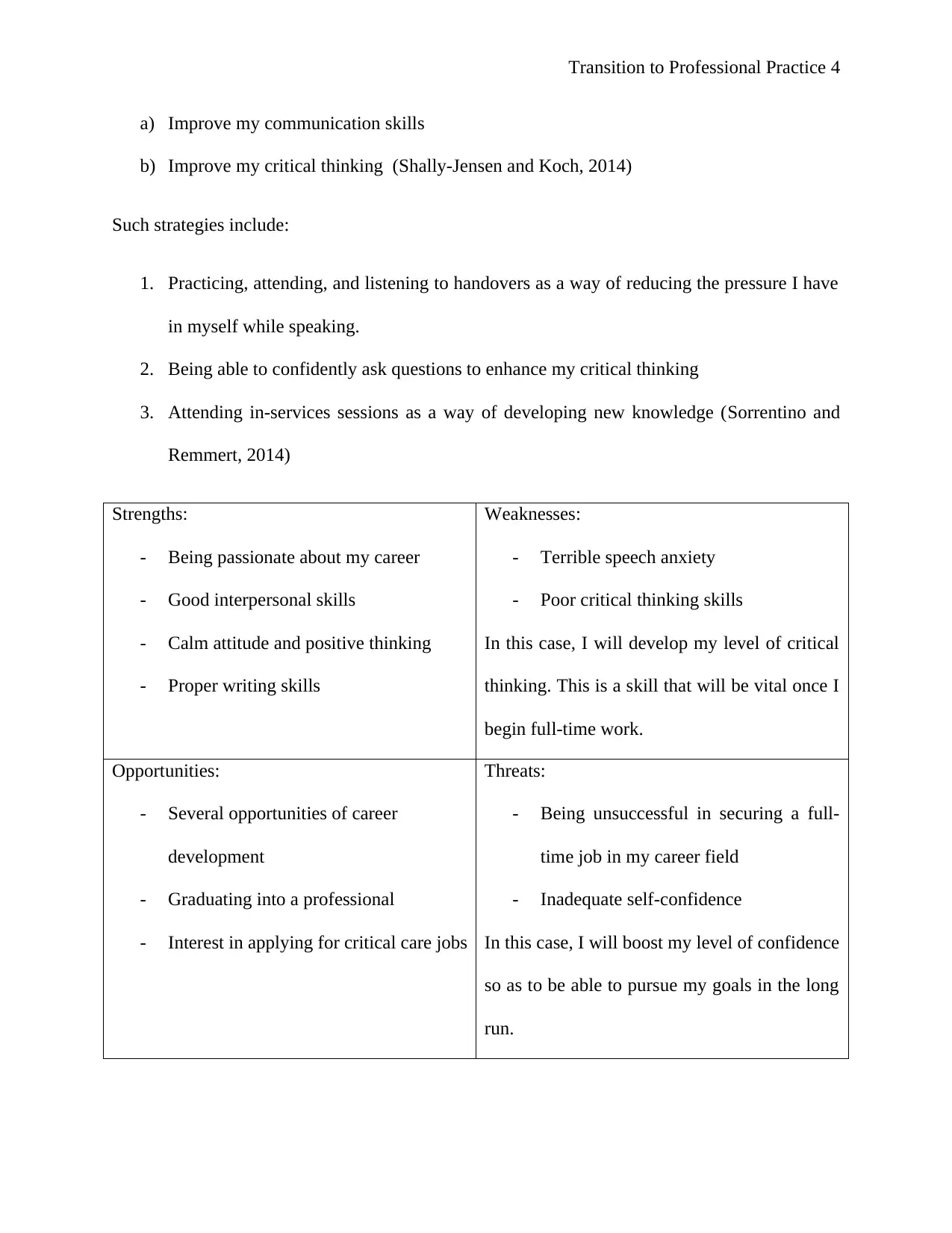
Transition to Professional Practice 4
a) Improve my communication skills
b) Improve my critical thinking (Shally-Jensen and Koch, 2014)
Such strategies include:
1. Practicing, attending, and listening to handovers as a way of reducing the pressure I have
in myself while speaking.
2. Being able to confidently ask questions to enhance my critical thinking
3. Attending in-services sessions as a way of developing new knowledge (Sorrentino and
Remmert, 2014)
Strengths:
- Being passionate about my career
- Good interpersonal skills
- Calm attitude and positive thinking
- Proper writing skills
Weaknesses:
- Terrible speech anxiety
- Poor critical thinking skills
In this case, I will develop my level of critical
thinking. This is a skill that will be vital once I
begin full-time work.
Opportunities:
- Several opportunities of career
development
- Graduating into a professional
- Interest in applying for critical care jobs
Threats:
- Being unsuccessful in securing a full-
time job in my career field
- Inadequate self-confidence
In this case, I will boost my level of confidence
so as to be able to pursue my goals in the long
run.
a) Improve my communication skills
b) Improve my critical thinking (Shally-Jensen and Koch, 2014)
Such strategies include:
1. Practicing, attending, and listening to handovers as a way of reducing the pressure I have
in myself while speaking.
2. Being able to confidently ask questions to enhance my critical thinking
3. Attending in-services sessions as a way of developing new knowledge (Sorrentino and
Remmert, 2014)
Strengths:
- Being passionate about my career
- Good interpersonal skills
- Calm attitude and positive thinking
- Proper writing skills
Weaknesses:
- Terrible speech anxiety
- Poor critical thinking skills
In this case, I will develop my level of critical
thinking. This is a skill that will be vital once I
begin full-time work.
Opportunities:
- Several opportunities of career
development
- Graduating into a professional
- Interest in applying for critical care jobs
Threats:
- Being unsuccessful in securing a full-
time job in my career field
- Inadequate self-confidence
In this case, I will boost my level of confidence
so as to be able to pursue my goals in the long
run.
Paraphrase This Document
Need a fresh take? Get an instant paraphrase of this document with our AI Paraphraser
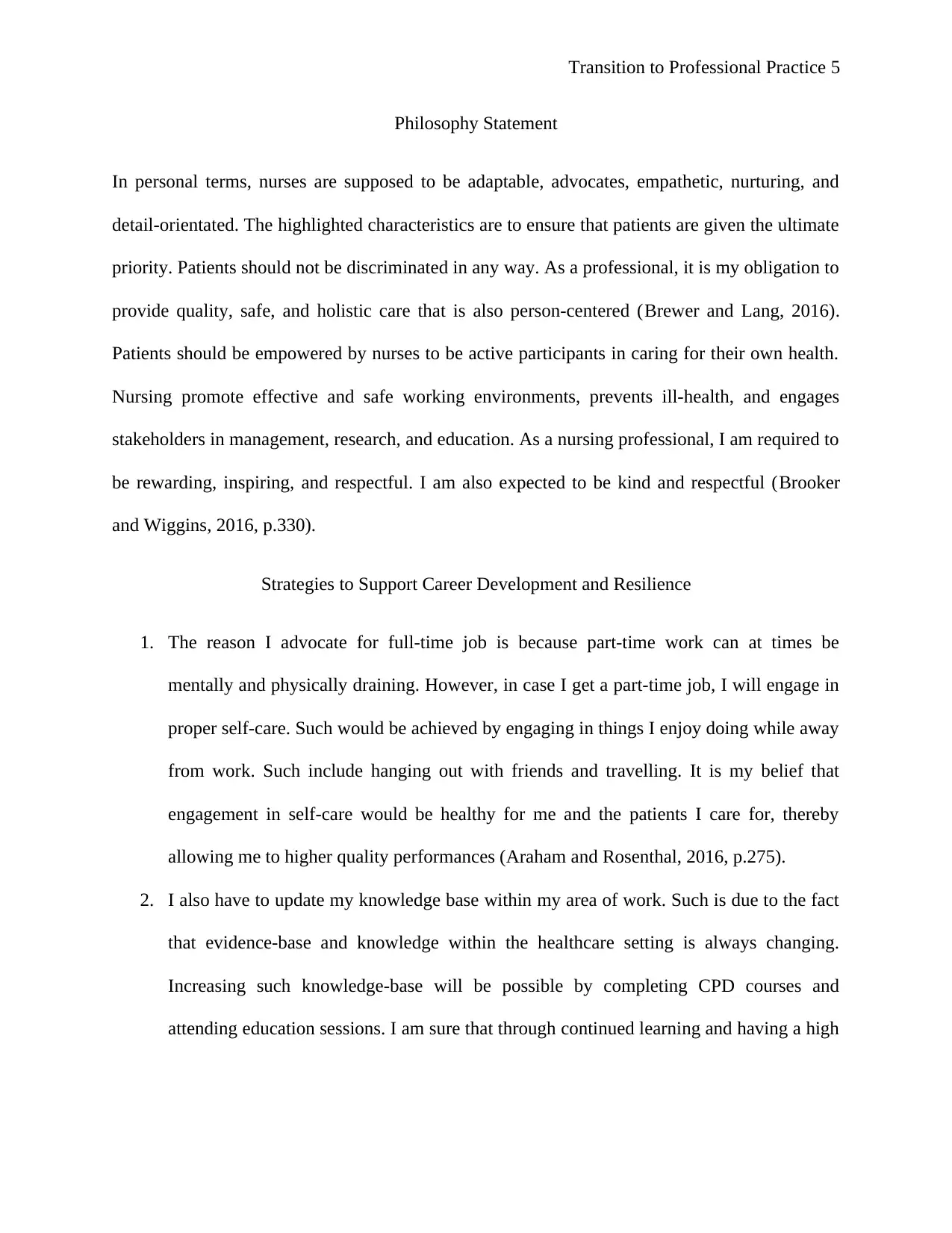
Transition to Professional Practice 5
Philosophy Statement
In personal terms, nurses are supposed to be adaptable, advocates, empathetic, nurturing, and
detail-orientated. The highlighted characteristics are to ensure that patients are given the ultimate
priority. Patients should not be discriminated in any way. As a professional, it is my obligation to
provide quality, safe, and holistic care that is also person-centered (Brewer and Lang, 2016).
Patients should be empowered by nurses to be active participants in caring for their own health.
Nursing promote effective and safe working environments, prevents ill-health, and engages
stakeholders in management, research, and education. As a nursing professional, I am required to
be rewarding, inspiring, and respectful. I am also expected to be kind and respectful (Brooker
and Wiggins, 2016, p.330).
Strategies to Support Career Development and Resilience
1. The reason I advocate for full-time job is because part-time work can at times be
mentally and physically draining. However, in case I get a part-time job, I will engage in
proper self-care. Such would be achieved by engaging in things I enjoy doing while away
from work. Such include hanging out with friends and travelling. It is my belief that
engagement in self-care would be healthy for me and the patients I care for, thereby
allowing me to higher quality performances (Araham and Rosenthal, 2016, p.275).
2. I also have to update my knowledge base within my area of work. Such is due to the fact
that evidence-base and knowledge within the healthcare setting is always changing.
Increasing such knowledge-base will be possible by completing CPD courses and
attending education sessions. I am sure that through continued learning and having a high
Philosophy Statement
In personal terms, nurses are supposed to be adaptable, advocates, empathetic, nurturing, and
detail-orientated. The highlighted characteristics are to ensure that patients are given the ultimate
priority. Patients should not be discriminated in any way. As a professional, it is my obligation to
provide quality, safe, and holistic care that is also person-centered (Brewer and Lang, 2016).
Patients should be empowered by nurses to be active participants in caring for their own health.
Nursing promote effective and safe working environments, prevents ill-health, and engages
stakeholders in management, research, and education. As a nursing professional, I am required to
be rewarding, inspiring, and respectful. I am also expected to be kind and respectful (Brooker
and Wiggins, 2016, p.330).
Strategies to Support Career Development and Resilience
1. The reason I advocate for full-time job is because part-time work can at times be
mentally and physically draining. However, in case I get a part-time job, I will engage in
proper self-care. Such would be achieved by engaging in things I enjoy doing while away
from work. Such include hanging out with friends and travelling. It is my belief that
engagement in self-care would be healthy for me and the patients I care for, thereby
allowing me to higher quality performances (Araham and Rosenthal, 2016, p.275).
2. I also have to update my knowledge base within my area of work. Such is due to the fact
that evidence-base and knowledge within the healthcare setting is always changing.
Increasing such knowledge-base will be possible by completing CPD courses and
attending education sessions. I am sure that through continued learning and having a high
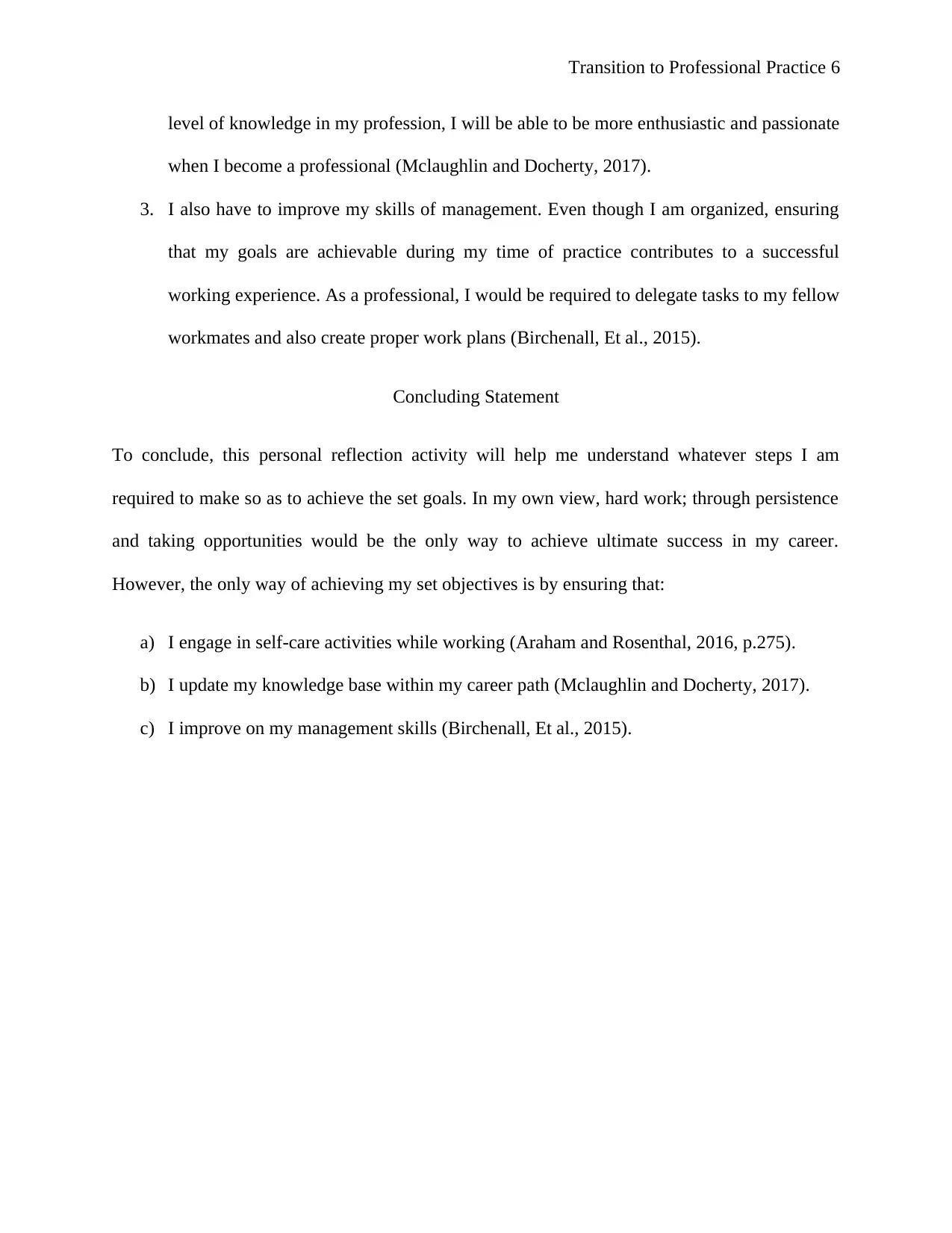
Transition to Professional Practice 6
level of knowledge in my profession, I will be able to be more enthusiastic and passionate
when I become a professional (Mclaughlin and Docherty, 2017).
3. I also have to improve my skills of management. Even though I am organized, ensuring
that my goals are achievable during my time of practice contributes to a successful
working experience. As a professional, I would be required to delegate tasks to my fellow
workmates and also create proper work plans (Birchenall, Et al., 2015).
Concluding Statement
To conclude, this personal reflection activity will help me understand whatever steps I am
required to make so as to achieve the set goals. In my own view, hard work; through persistence
and taking opportunities would be the only way to achieve ultimate success in my career.
However, the only way of achieving my set objectives is by ensuring that:
a) I engage in self-care activities while working (Araham and Rosenthal, 2016, p.275).
b) I update my knowledge base within my career path (Mclaughlin and Docherty, 2017).
c) I improve on my management skills (Birchenall, Et al., 2015).
level of knowledge in my profession, I will be able to be more enthusiastic and passionate
when I become a professional (Mclaughlin and Docherty, 2017).
3. I also have to improve my skills of management. Even though I am organized, ensuring
that my goals are achievable during my time of practice contributes to a successful
working experience. As a professional, I would be required to delegate tasks to my fellow
workmates and also create proper work plans (Birchenall, Et al., 2015).
Concluding Statement
To conclude, this personal reflection activity will help me understand whatever steps I am
required to make so as to achieve the set goals. In my own view, hard work; through persistence
and taking opportunities would be the only way to achieve ultimate success in my career.
However, the only way of achieving my set objectives is by ensuring that:
a) I engage in self-care activities while working (Araham and Rosenthal, 2016, p.275).
b) I update my knowledge base within my career path (Mclaughlin and Docherty, 2017).
c) I improve on my management skills (Birchenall, Et al., 2015).
⊘ This is a preview!⊘
Do you want full access?
Subscribe today to unlock all pages.

Trusted by 1+ million students worldwide
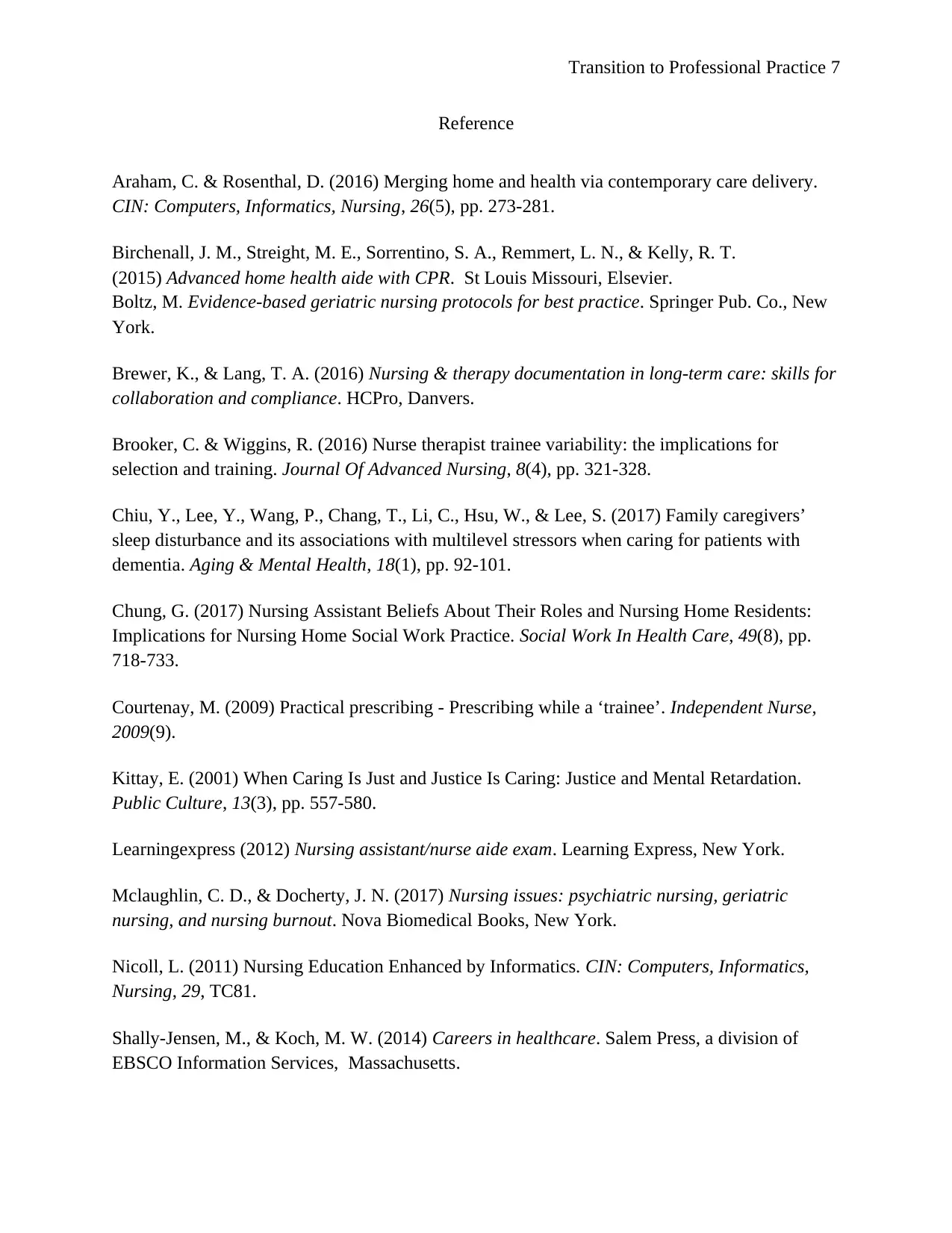
Transition to Professional Practice 7
Reference
Araham, C. & Rosenthal, D. (2016) Merging home and health via contemporary care delivery.
CIN: Computers, Informatics, Nursing, 26(5), pp. 273-281.
Birchenall, J. M., Streight, M. E., Sorrentino, S. A., Remmert, L. N., & Kelly, R. T.
(2015) Advanced home health aide with CPR. St Louis Missouri, Elsevier.
Boltz, M. Evidence-based geriatric nursing protocols for best practice. Springer Pub. Co., New
York.
Brewer, K., & Lang, T. A. (2016) Nursing & therapy documentation in long-term care: skills for
collaboration and compliance. HCPro, Danvers.
Brooker, C. & Wiggins, R. (2016) Nurse therapist trainee variability: the implications for
selection and training. Journal Of Advanced Nursing, 8(4), pp. 321-328.
Chiu, Y., Lee, Y., Wang, P., Chang, T., Li, C., Hsu, W., & Lee, S. (2017) Family caregivers’
sleep disturbance and its associations with multilevel stressors when caring for patients with
dementia. Aging & Mental Health, 18(1), pp. 92-101.
Chung, G. (2017) Nursing Assistant Beliefs About Their Roles and Nursing Home Residents:
Implications for Nursing Home Social Work Practice. Social Work In Health Care, 49(8), pp.
718-733.
Courtenay, M. (2009) Practical prescribing - Prescribing while a ‘trainee’. Independent Nurse,
2009(9).
Kittay, E. (2001) When Caring Is Just and Justice Is Caring: Justice and Mental Retardation.
Public Culture, 13(3), pp. 557-580.
Learningexpress (2012) Nursing assistant/nurse aide exam. Learning Express, New York.
Mclaughlin, C. D., & Docherty, J. N. (2017) Nursing issues: psychiatric nursing, geriatric
nursing, and nursing burnout. Nova Biomedical Books, New York.
Nicoll, L. (2011) Nursing Education Enhanced by Informatics. CIN: Computers, Informatics,
Nursing, 29, TC81.
Shally-Jensen, M., & Koch, M. W. (2014) Careers in healthcare. Salem Press, a division of
EBSCO Information Services, Massachusetts.
Reference
Araham, C. & Rosenthal, D. (2016) Merging home and health via contemporary care delivery.
CIN: Computers, Informatics, Nursing, 26(5), pp. 273-281.
Birchenall, J. M., Streight, M. E., Sorrentino, S. A., Remmert, L. N., & Kelly, R. T.
(2015) Advanced home health aide with CPR. St Louis Missouri, Elsevier.
Boltz, M. Evidence-based geriatric nursing protocols for best practice. Springer Pub. Co., New
York.
Brewer, K., & Lang, T. A. (2016) Nursing & therapy documentation in long-term care: skills for
collaboration and compliance. HCPro, Danvers.
Brooker, C. & Wiggins, R. (2016) Nurse therapist trainee variability: the implications for
selection and training. Journal Of Advanced Nursing, 8(4), pp. 321-328.
Chiu, Y., Lee, Y., Wang, P., Chang, T., Li, C., Hsu, W., & Lee, S. (2017) Family caregivers’
sleep disturbance and its associations with multilevel stressors when caring for patients with
dementia. Aging & Mental Health, 18(1), pp. 92-101.
Chung, G. (2017) Nursing Assistant Beliefs About Their Roles and Nursing Home Residents:
Implications for Nursing Home Social Work Practice. Social Work In Health Care, 49(8), pp.
718-733.
Courtenay, M. (2009) Practical prescribing - Prescribing while a ‘trainee’. Independent Nurse,
2009(9).
Kittay, E. (2001) When Caring Is Just and Justice Is Caring: Justice and Mental Retardation.
Public Culture, 13(3), pp. 557-580.
Learningexpress (2012) Nursing assistant/nurse aide exam. Learning Express, New York.
Mclaughlin, C. D., & Docherty, J. N. (2017) Nursing issues: psychiatric nursing, geriatric
nursing, and nursing burnout. Nova Biomedical Books, New York.
Nicoll, L. (2011) Nursing Education Enhanced by Informatics. CIN: Computers, Informatics,
Nursing, 29, TC81.
Shally-Jensen, M., & Koch, M. W. (2014) Careers in healthcare. Salem Press, a division of
EBSCO Information Services, Massachusetts.
Paraphrase This Document
Need a fresh take? Get an instant paraphrase of this document with our AI Paraphraser
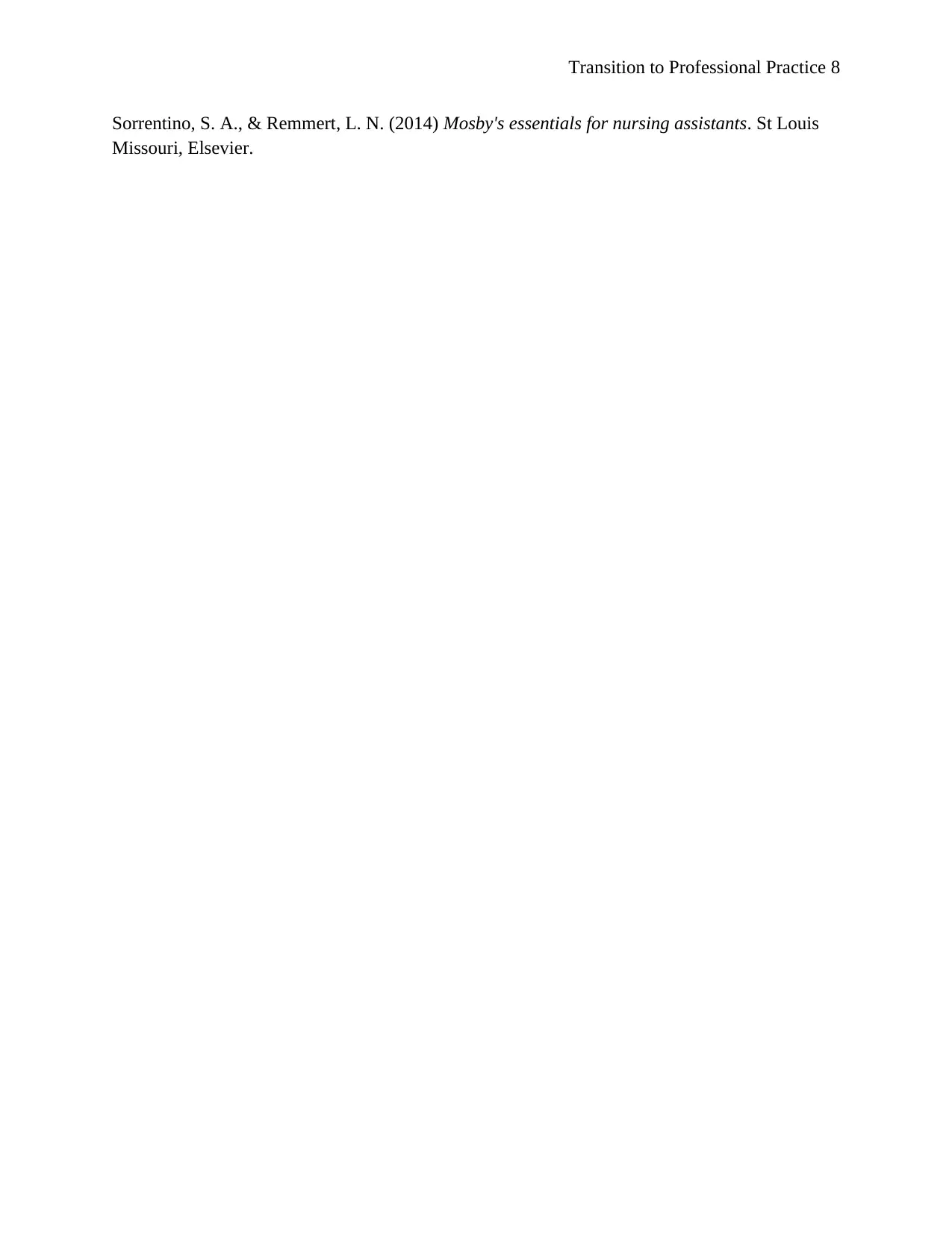
Transition to Professional Practice 8
Sorrentino, S. A., & Remmert, L. N. (2014) Mosby's essentials for nursing assistants. St Louis
Missouri, Elsevier.
Sorrentino, S. A., & Remmert, L. N. (2014) Mosby's essentials for nursing assistants. St Louis
Missouri, Elsevier.
1 out of 8
Related Documents
Your All-in-One AI-Powered Toolkit for Academic Success.
+13062052269
info@desklib.com
Available 24*7 on WhatsApp / Email
![[object Object]](/_next/static/media/star-bottom.7253800d.svg)
Unlock your academic potential
Copyright © 2020–2025 A2Z Services. All Rights Reserved. Developed and managed by ZUCOL.





